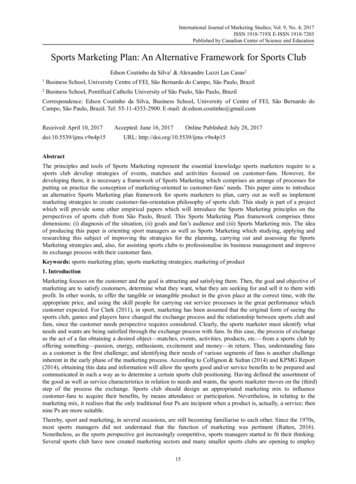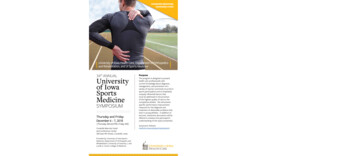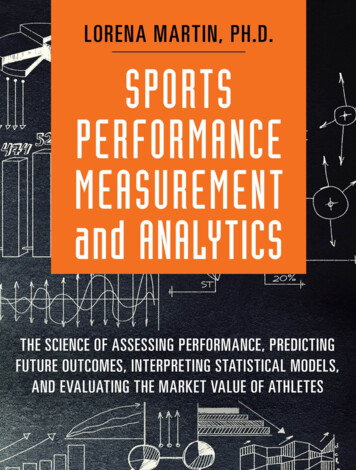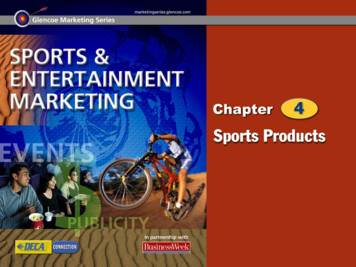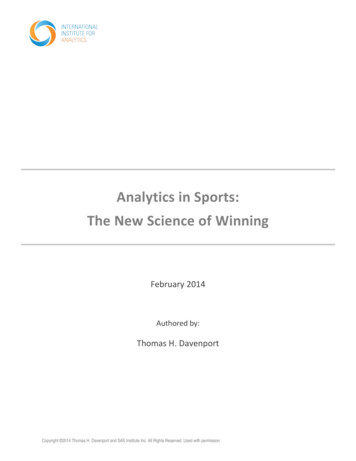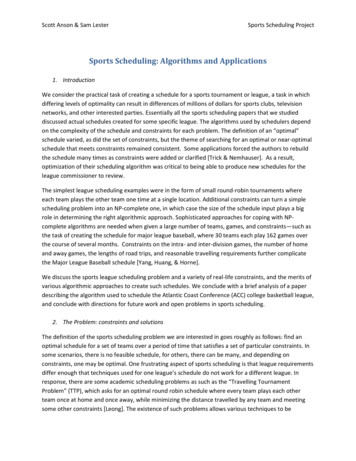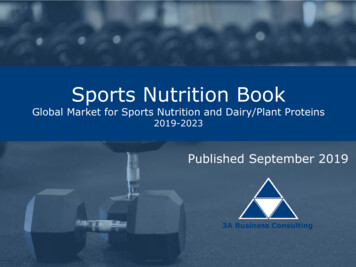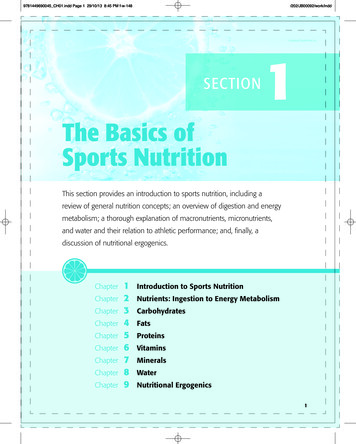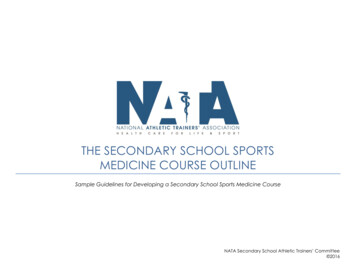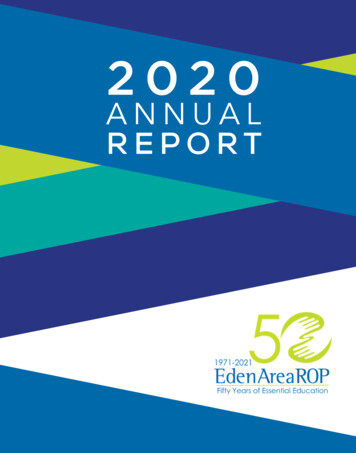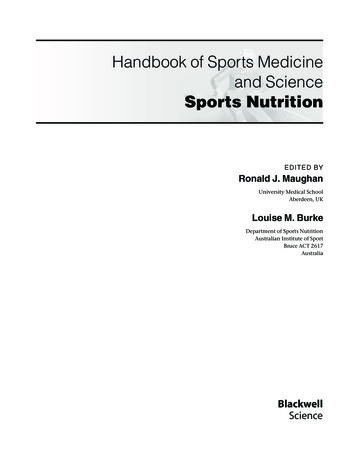
Transcription
Handbook of Sports Medicineand ScienceSports NutritionEDITED BYRonald J. MaughanUniversity Medical SchoolAberdeen, UKLouise M. BurkeDepartment of Sports NutritionAustralian Institute of SportBruce ACT 2617AustraliaBlackwellScience
Handbook of Sports Medicine and ScienceSports Nutrition
IOC Medical CommissionSub-Commission on Publications inthe Sport SciencesHoward G. Knuttgen PhD (Co-ordinator)Boston, Massachusetts, USAHarm Kuipers MD, PhDMaastricht, The NetherlandsPer A.F.H. Renström MD, PhDStockholm, Sweden
Handbook of Sports Medicineand ScienceSports NutritionEDITED BYRonald J. MaughanUniversity Medical SchoolAberdeen, UKLouise M. BurkeDepartment of Sports NutritionAustralian Institute of SportBruce ACT 2617AustraliaBlackwellScience
2002 by Blackwell Science Ltda Blackwell Publishing companyBlackwell Science, Inc., 350 Main Street, Malden, Massachusetts 02148-5018, USABlackwell Science Ltd, Osney Mead, Oxford OX2 0EL, UKBlackwell Science Asia Pty Ltd, 550 Swanston Street, Carlton, Victoria 3053, AustraliaBlackwell Wissenschafts Verlag, Kurfürstendamm 57, 10707 Berlin, GermanyThe right of the Author to be identified as the Author of this Work has been asserted in accordance with the Copyright,Designs and Patents Act 1988.All rights reserved. No part of this publication may be reproduced, stored in a retrieval system, or transmitted, in any form orby any means, electronic, mechanical, photocopying, recording or otherwise, except as permitted by the UK Copyright,Designs and Patents Act 1988, without the prior permission of the publisher.First published 2002Library of Congress Cataloging-in-Publication DataSports nutrition / edited by Ronald J. Maughan, Louise Burke.p. cm. — (Handbook of sports medicine and science)Includes index.ISBN 0-632-05814-51. Athletes—Nutrition. I. Maughan, Ron J., 1951– II. Burke, Louise.III. Series.TX361.A8 S663 2002613.2′024′796—dc212002007304ISBN 0-632-05814-5A catalogue record for this title is available from the British LibrarySet in 8.75/12pt Stone by Graphicraft Limited, Hong KongPrinted and bound in Great Britain byMPG Books Ltd, Bodmin, CornwallCommissioning Editor: Andrew RobinsonProduction Editor: Julie ElliottProduction Controller: Kate CharmanFor further information on Blackwell Science, visit our website:www.blackwell-science.com
ContentsList of contributors, viPart 2 Nutrition for competitionForewords by the IOC, viiiPreface, ix7 Preparation for competition, 758 Eating and drinking during exercise, 84Part 1 Nutrition needs for training1 Exercise and energy demands, 32 Fuels used in exercise: carbohydrateand fat, 153 Protein and amino acid requirements ofathletes, 264 Micronutrients: vitamins and minerals, 355 Fluids and electrolytes, 516 Alcohol and sport, 649 Post-event recovery, 93Part 3 Practical sports nutrition10 Assessing nutritional status and needs, 10711 Changing size and body composition, 11812 Dietary supplements and ergogenic aids, 12913 Practical strategies to meet nutrition goals, 14714 Eating well while traveling, 15415 Strategies for special populations, 16116 Strategies for special environments: heat, 173Index, 183v
List of contributorsThe following are contributors to the Expertcomment and Case Studies found throughoutthe book.Louise M. Burke PhD, Department of SportsNutrition, Australian Institute of Sport, Bruce, ACT 2617,AustaliaPriscilla M. Clarkson PhD, Department ofExercise Science, University of Massachusetts, Amherst,Massachusetts 01003, USAGregory R. Cox, MSc (Nut), Department of SportsNutrition, Australian Institute of Sport, PO Box 176,Belconnen, ACT 2616 AustraliaMikael Fogelholm ScD, The UKK Institute forHealth Promotion Research, PO Box 30, FIN-33501Tampere, FinlandMike Gleeson PhD, School of Sport and ExerciseSciences, University of Birmingham, Birmingham B152TT, UKJohn A. Hawley PhD, Department of HumanBiology and Movement Science, Faculty of Biomedical andHealth Science, RMIT University, PO Box 71, Bundoora,Victoria 3083, AustraliaPeter W.R. Lemon PhD, 3M Centre, University ofWestern Ontario, London, Ontario N6A 3K7, CanadaHenry C. Lukaski PhD, USDA ARS Grand ForksHuman Nutrition Center, PO Box 9034, Grand Forks,ND 58202-9034, USAMelinda M. Manore PhD, Nutrition and FoodManagement Department, Oregon State University, 108Milam Hall, Corvallis, Oregon, 97331-5109, USARonald J. Maughan PhD, Department ofBiomedical Sciences, University Medical School, Foresterhill,Aberdeen AB25 2ZD, UKRobert Murray PhD, Exercise PhysiologyLaboratory, Quaker Oats Company, 617 West Main Street,Barrington, Illinois 60010, USAHelen O’Connor PhD, Department of Exercise andSport Science, University of Sydney, Lidcombe, NSW 2141,AustraliaBente Klarlund Pedersen MD, Department ofInfectious Diseases M, Rigshospitalet, Tagensvej 20,Copenhagen N, DenmarkKarin Piehl-Aulin MD, Section for Sports Medicine,LIVI, Box 1992, S-791-19 Falun, SwedenLinda Houtkooper PhD, Department ofNutritional Sciences, Special Assistanta CooperativeExtension Director, University of Arizona, Tucson,Arizona 86721viSusan M. Shirreffs PhD, Department ofBiomedical Sciences, University Medical School, Foresterhill,Aberdeen AB25 2ZD, UK
List of conributors viiPatricia Thompson MSc(Nut), 3 York CastleAvenue, Kingston 6, Jamaica W.I.Anton J.M. Wagenmakers PhD, Departmentof Human Biology, Maastricht University, PO Box 616,6200 MD Maastricht, The NetherlandsClyde Williams PhD, Department of PE and SportsScience, Loughborough University, Loughborough,Leicestershire LE11 3TU, UK
Forewords by the IOCThe scientific area of Sports Nutrition has experienced a phenomenal expansion of knowledgeduring recent years. Even 30 years ago, the athletesand the associated health care professionals whoworked with the athletes lacked very basic information on the possible relationships among foodintake, nutritional status, conditioning programmes,and competitive performance.During the past three decades of laboratory andfield research, a broad foundation of science hasbeen laid in scientific literature. An area of sciencecalled Sports Nutrition has now been establishedand it has served as the basis for careful planning ofthe dietary patterns and food ingestion for athletesduring periods of training and as directly related tocompetition.I would like to thank the IOC Medical Commission and its Sub-commission on Publications in theSport Sciences for this valuable contribution to theliterature in sports medicine and the sport sciences.Dr Jacques RoggeIOC PresidentTo supplement and complement the earlier volumes in the Handbook series that have dealt witheither individual or team sports, this Handbook onSports Nutrition deals with the general considerations of the energy demands of physical exerciseand sport and the associated demands for appropriate nutrient intake.All of the different aspects of nutrition related tosports have been taken into consideration, including age, sex, competition, and training. Each area isclearly explained and easily accessible for anyonedealing with athletes.This Handbook will certainly be of great interestto nutritionists, sports medicine physicians, athletic trainers, and knowledgeable athletes alike. Itwill serve as the most practical reference availableconcerning nutrition applied to exercise and sportfor many years to come.I would like to congratulate Ronald Maughanand Louise Burke, for having taken such a uniqueapproach with the formulation of this volumein the series, “Handbooks of Sports Medicine andScience”.Prince Alexandre de MerodeIOC Medical Commission Chairmanviii
PrefaceIn the modern world of sport, performing at yourbest requires commitment at many levels. It is nolonger enough to rely on natural talent, hard training, superior equipment or a will to winain fact,among the top competitors in any sport these factors are often equalized. Under these conditions,sound nutritional practices can make the differencebetween winning and losing, or between doing apersonal best and just finishing the event. Whetherthe stakes are fame and millions of dollars, or thesatisfaction of achieving a sporting goal, there areclear rewards for eating well. This book is designedto provide an up-to-date summary of the scienceand practice of sports nutrition.The importance of sports nutrition is reflectedat all levels of sport. The International OlympicCommittee has conducted extensive reviews of theavailable scientific knowledge on nutrition for athletes at its 1991 Consensus Conference, and in its51-chapter textbook Nutrition in Sport, Volume VIIof the Encyclopaedia of Sports Medicine. Otherinternational governing bodies of sport have produced position stands on this topic. At the practicallevel, most professional teams and serious athletesuse the services of a sports dietitian or sports nutritionist to advise them on how to eat to perform atan optimal level. Many other sports medicine professionals, sports scientists, coaches, and trainersare involved in this education process or in theimplementation of sound sports nutrition strategies. Athletes and their families must have a goodunderstanding of the practice of sports nutrition aswell as the principles that support it.This book is divided into three sections. The firstdeals with issues relating to training, where the goalis to prepare the athlete to reach the starting line inthe best possible form. Everyday eating patternsmust supply the athlete with the fuel and nutrientsneeded to optimize their performance during training sessions and to recover quickly afterwards.Increasing evidence now suggests that nutrientintake in the period after training can influence theresponses taking place in the muscles and othertissues, allowing more effective adaptation to thetraining session. The athlete must also eat to stay ingood health and in good shape. Special strategies offood and fluid intake before, during, and after aworkout may help to reduce fatigue and enhanceperformance. These will often be important in thecompetition setting, but must be practised and finetuned during training so that successful strategiescan be identified.Section 2 on competition eating deals with thenutritional challenges that cause fatigue or limitperformance during sport and exercise. Many ofthese relate to the fuel and hydration status of theathlete. Strategies that reduce the disturbance tofluid and fuel status caused by exercise can reduceor delay the onset of fatigue, thus enhancing performance, and these strategies can be undertakenbefore, during, or after exercise.Finally, Section 3 deals with the practical side ofsports nutrition, looking at the ways that scientificknowledge can be translated into eating strategiesand menu choices. This includes some of the hottopics in sportasuch as changing physique or usingix
x Prefacesupplements to optimize performance. The individual needs of specific populations or for specialenvironments are also be covered.This book provides a accompaniment to the otherIOC textbooks and handbooks on sports medicine,and we hope that it will provide a useful addition toresources used by athletes and coaches to preparethemselves to perform at the highest level.Ron Maughan and Louise Burke, 2002
PART 1NUTRITION NEEDSFOR TRAINING
Chapter 1Exercise and energy demandsIntroductionDetermination of energy needsMany of the world’s nutrition problems relate toa failure to match energy intake to energy requirements. In many countries, chronic undernutritionis a leading cause of mortality, especially in infantsand children. In most industrialized countries, however, excess dietary energy is the major problem,with obesity and its sequelae being a major cause ofmorbidity and mortality. Most adults succeed inmaintaining their body weight within fairly narrowlimits, indicating that the match between energyintake and energy expenditure is quite close. Thesecontrol mechanisms are not perfect, however, andit has been estimated that the body fat content ofthe average male doubles between the ages of 20and 50 years, and that of women typically increasesby 50%.Training and competing in sport involve a rangeof activities of varying energy demands. Athletesface a spectrum of challenges in meeting their individual energy demandsaranging from difficultiesin achieving sufficiently high energy intakes tomeet very high energy needs, to the need to restrictenergy intake to achieve and maintain a low weight(body mass) and body fat level. This chapter willoverview the factors that determine the energyneeds of athletes and recreationally active people,and will comment on the energy intakes reportedby athletes in a variety of sports.The food that we eat provides the fuels and buildingmaterials for life, supplying both the structural elements of the body and the means of sustainingthe body’s energy-requiring processes. Energy isneeded for all biosynthetic pathways and for maintaining the internal environment of the body. Afterthe body’s basal needs have been met, additionalenergy is needed to fuel muscular activity, whetherthis is carried out for occupational, recreational, orsporting purposes.The individual components considered to makeup total energy requirements of an individual aresummarized in Fig. 1.1, and include: Basal or resting metabolic rate (the energyrequired to maintain body systems). This should bemeasured in a thermoneutral environment. Thermic effect of food (the increase in energyexpenditure following the intake of food that isassociated with the digestion, absorption, and metabolism of food and nutrients). The thermic effect of activity, including theenergy cost of spontaneous movements as well asplanned muscular activities such as exercise. The cost of growth.The primary factors that determine the energyrequirement of athletes in training are body sizeand the training load. The importance of body massis often underestimated, but the active tissue massinfluences the basal metabolic cost of living aswell as the energy cost of exercise. Total energy3
4 Chapter 1ThermiceffectTotal ysicalactivityDurationIntensityModeBody massSpontaneous physicalactivityGeneticsHormones/SNSThermic effect of foodAmount/typeof foodBasal metabolic rateexpenditure can be expected to vary betweenathletes who range in size from the female gymnastor marathon runner at less than 40 kg to the heavyweight weightlifter at 120 kg and the sumo wrestlerin excess of 200 kg. The total training load willincrease energy requirements above those of normal daily living and in some individuals may beas high as 50% of total daily energy expenditure.The three important components of any trainingprogramaintensity, duration, and frequencyawillall influence total energy expenditure.Energy costs of exerciseIn the simple locomotor sports that involve walking,running, or cycling, the energy cost of activity isreadily determined and can be shown to be a function of speed. Whether body mass is supported bythe muscles as in running, or the athlete is seated asin rowing or cycling, or where it must be movedagainst gravity as in cycling uphill, then this too isan important factor in determining the energy cost.For walking, running, and cycling at low speeds,there is a linear relationship between velocity andenergy cost, if the energy cost is expressed relativeto body weight. At higher speeds, the relationshipbecomes curvilinear and the energy cost increasesdisproportionately. In cycling a large part of this isdue to the need to overcome air resistance, whichincreases as the square of velocity. The effect of airresistance becomes significant at the speeds involvedin cycling, and explains the attention paid by eliteGeneticsAgeSexLean body massHormones/SNSFig. 1.1 The components of energyexpenditure.cyclists to methods of reducing it. Bicycle design,cycling position, and clothing all affect the aerodynamics and hence the energy cost.At the speeds involved in walking and runningthrough still air, air resistance is not a significantfactor, but the relationship is nonetheless curvilinear. The reason for this seems to be a reduced mechanical efficiency as velocity increases. At very lowspeeds, the energy cost of walking is less than that ofjogging, because of the smaller vertical displacements of the centre of mass; as velocity increases,however, the cost of walking increases faster thanthat of running, and at speeds in excess of about 6–7 km·h–1, running is less energetically demandingthan jogging. As a rough approximation, the energycost of walking or jogging is about 1 kilocalorieper kilogram of body mass per kilometer of distance covered. There are, however, large differencesbetween individuals in the energy cost of even simple activities such as running, and these differencesin the efficiency of movement may translate intosubstantial differences in energy demand.It is often recommended that 20–30 min of moderate intensity exercise three times per week issufficient exercise to confer some protection againstcardiovascular disease: if this exercise is in the formof jogging, the energy expenditure will be about4 MJ (1000 kcal) per week for the average 70-kgindividual. The energy cost of running a marathonis equivalent to only about 12 MJ (3000 kcal). However, even a small daily contribution from exercise to total daily energy expenditure will have a
Exercise and energy demandscumulative effect on a long-term basis. For obeseindividuals, whose exercise capacity is low, the roleof physical activity in raising energy expenditure isnecessarily limited, but this effect is offset to somedegree by the increased energy cost of weightbearing activity.There have been several attempts to identify thefactors that might account for the differences inrunning economy which exist among runners.When elite and non-elite runners are compared,there is generally a slightly shorter stride length andcorrespondingly higher stride frequency in the eliterunners when running at the same speed. Somestudies have shown that the extent of vertical oscillation of the centre of gravity does not vary betweenrunners of different levels of ability, but otherstudies have found differences. It seems unlikelythat any single variable can account for differencesin running economy, but rather that many differentfactors each make a small contribution to theobserved differences that exist between individuals.In most sports, the pattern of energy is variable,and is therefore even more difficult to quantify: infield games such as soccer, play consists of sprints,periods of jogging at submaximal speed, walking,and resting. The overall energy cost depends onmany factors, including the total distance covered.It must also always be remembered that the fitterthe individual, the higher the overall rate of energyexpenditure. Estimates made from match analysissuggest that most top-class soccer players cover atotal of about 8–12 km during a game. The distancemay vary between the two halves, and also dependson the level of play and the position of the individual in the team. The daily energy expenditureduring typical training of English professionalplayers has been estimated to be approximately6.1 MJ (1500 kcal). The only technique that mightbe expected to give a reliable estimate of energyexpenditure in a situation such as this is the doublylabeled water method, but this has not yet beenapplied to the wide range of team sports.Tables of the energy cost of a wide range of different sports activities are available, but these have tobe considered as crude approximations at best. Thebody mass and fitness level of the performer willhave major influences on the energy cost of training, and even when these factors are similar, there5may be differences in the mechanical efficiency, aswell as in the energy expenditure during other dailyactivities. Because of this, applying mean valuesmay not be helpful when providing advice for anindividual.Evidence suggests that the metabolic rate mayremain elevated for at least 12 and possibly up to24 h after very prolonged intense exercise. Theathlete training at near to the maximum sustainable level, who already has a very high energydemand, will find this increased further by the elevation of postexercise metabolic rate, and this willincrease the difficulties that many of these athleteshave in meeting their energy demand. It seemsunlikely, however, that metabolic rate remains elevated for long periods after more moderate exercise.The recreational exerciser, for whom the primarystimulus to exercise is often control of body weightor reduction of body fat content, will not thereforebenefit to any measurable extent from this effect.Energy costs of growth orchanging body massThe requirement for growth is an important factorin the energy needs of young athletes who have notreached full maturity. In these cases, energy intakemust exceed expenditure if growth is to take place.Some athletes, mostly in events where a high poweroutput is an important part of successful performance, will also benefit from an increased body mass,and an increase in muscle mass rather than in fatmass is usually desired. In some events, such as theheaviest weight categories in weightlifting and inthe combat sports, and in the throwing events intrack and field, a high absolute mass may be important, and a high body fat content is often seen in themost successful competitors. If the body mass is toincrease, there must be an excess of energy intakeover expenditure. The reverse situation, a need toreduce body mass and especially to reduce the bodyfat content, is also frequently encountered. Thereare particular problems in reducing the energy taketo a level that will result in a loss of body mass without compromising the ability to sustain the trainingload. In seasonal sports such as soccer or rugby, asubstantial gain in body fat is not unusual in the offseason, and the preseason training for these athletes
6 Chapter 1often involves a combination of sudden increases inthe training load in combination with a restrictionof energy intake.Dietary strategies which assist athletes to manipulate their body mass and body composition arediscussed in more detail in Chapters 11 and 13.Determining individual requirementsfor energyAs with the general population, there is likely to bea large variability in energy requirements betweenathletes, even when body mass and training loadsare similar. The reasons for this remain obscure.However, as shown in Fig. 1.1, the determinants ofthe components of energy expenditure are complexand multifactorial.Each athlete must identify their own energyrequirement and their own ideal body mass andbody fat content. An adequate energy intake isachieved when body weight and body fat contentare maintained at a level that is appropriate for thesport and healthy for the athlete. In a small numberof sports situations, there appears to be a conflictbetween the demands of performance at elite leveland a body composition level that is optimal forhealth. Examples of such sports are primarily thosewhere performance is based on subjective aestheticassessment, including women’s gymnastics and icedancing, but also include long-distance running.Additional needs for growth and development mustbe added to the cost of daily activity where youngathletes are involved, and an increase in body mass,and in body fat content, is a normal part of thematuration process.The energy requirements of an individual can bedetermined by a number of methods, each of whichhas some advantages and disadvantages. The mostcommon laboratory-based method is indirect calorimetry, in which energy expenditure is calculatedfrom the rates of oxygen consumption and production of carbon dioxide. Of course this requiresequipment such as a Douglas bag, ventilation hood,or metabolic chamber in which expired air samplescan be accurately collected and analysed. Disadvantages of this technique include expense and theneed for specialized equipment and trained personnel. Most importantly, the technique usuallyinterferes with the performance of normal dailyliving and exercise activities, meaning that it measures an artificial situation of daily energy expenditure. On the other hand, it can be used to measurethe individual components of energy expenditureafor example resting metabolic rate, the thermicresponse to a meal, and the energy cost of variousexercise activities.More recently, the doubly labeled water (DLW)technique has been developed and validated toestimate energy expenditure. In this technique, thesubject ingests a sample of water that has beenlabeled with stable (non-radioactive) isotopes ofboth hydrogen and oxygen (2H218O). Energy expenditure can be calculated via the periodic monitoringof the concentration of these isotopes in body fluidsto compare the different rates of disappearance ofthese isotopes (see Expert Comment 1). This technique has no effect on the daily activities of the subject and measures the total energy expenditure, so itis particularly useful for monitoring energy expenditure in the field over a period of days or weeks.Nevertheless, the cost and availability of the DLWsample and analyses restrict the use of this methodto the realms of research. Indirect calorimetry andDLW estimates are rarely used in the managementof individual athletes, except perhaps where theyare used to investigate the case of an athlete whohas an apparent disturbance of energy balance.The most accessible and practical way to assessthe energy requirements of the athlete is to use prediction equations based on assessments of restingmetabolic rate and the energy cost of daily activities. Several equations are available to predict restingmetabolic rate from factors such as age, height,weight, or lean body mass. Once resting metabolicrate is estimated, it must then be multiplied byvarious activity factors to determine the total dailyenergy expenditure. At the simplest level, an overallactivity factor is applied to the whole day to represent the athlete’s typical exercise level. At the mostcomplex level, an athlete might complete an intricate activity diary, with the energy cost of each activity undertaken over the day being separately addedto calculate the final prediction of total energyexpenditure. In most cases the factorial information
Exercise and energy demandsused to predict the cost of activities is genericallyderived. However in some research projects or casesof individual therapy, measurements may be madeof the exact energy cost of an individual’s exerciseactivitiesafor example, the cost of their typicaltraining and competition activities. While thisprotocol can provide a general estimation of anathlete’s energy requirements, the possibility forsubstantial error should be taken into account.Even if athletes do not have access to facilitiesfor estimation of their energy requirements, theyshould be able to identify when they are in energybalance by monitoring long-term changes in bodymass as part of their training diary. The athleteshould be weighed at the same time of day, andunder the same conditionsamany athletes use theirearly morning weight, taken just after waking andgoing to the toilet but before breakfast, as their truebody weight. Small fluctuations from day to dayshould be ignored, and hydration status should alsobe taken into account as a cause of variations inbody weight. However, trends in weight change overa week or more, whether upwards or downwards,indicate an imbalance between energy intake andexpenditure. Assessment of body composition, andmore specifically of body fat content, requires moresophisticated procedures (see Chapter 11).Energy intake of athletesIf body weight and performance levels are to bemaintained during periods of intense training, thehigh rate of energy expenditure must be matchedby an equally high energy intake. Available datafor most athletes suggest that they are in energybalance within the limits of the techniques usedfor measuring intake and expenditure. This is to beexpected, as a chronic deficit in energy intake wouldlead to a progressive loss of body mass. Because theyoften fall at or beyond the extremes of the normalrange, the dietary habits of athletes in differentsports have been extensively studied.Extreme endurance activities that involve veryhigh levels of energy expenditure on a daily basisare now rarely encountered in occupational tasks.The average daily metabolic rate of lumberjacks was7estimated in the 1930s to be about 4 times thebasal metabolic rate, and similar values have beenreported elsewhere, suggesting that this may beclose to the upper limit of physical exercise that canbe sustained on a long-term basis. In the short term,sporting activities can involve much higher levelsof energy output: the world record for distance runin 24 h is 286 km, which requires an energy expenditure of about 80 MJ (20 000 kcal). Such an effort,however, results in considerable depletion of thebody’s energy reserves, and must be followed by aperiod of recovery.Very high levels of daily energy expenditureare more often a feature of training than of competition, but there are some competitive events thatrequire high levels of activity to be sustained formany consecutive days. One of the most obviousexamples is the multistage cycle tour, of which themost famous is the Tour de France. Measurementson some of the competitors have shown that thesuccessful riders manage to maintain body weightin spite of a mean daily energy expenditure of 32 MJ(8000 kcal) sustained over a 3-week period. Thosecyclists who are unable to meet the daily energyrequirement are unable to complete the race. Inmultiday running events, it appears that intake andexpenditure may be less well balanced, althoughindividual case histories of successful runners undertaking non-stop races have reported intakes of25–50 MJ (6000–12 500 kcal) per 24-h period overperiods of 5–9 days. There is a tendency in theseraces for performance to deteriorate over t
Sport Sciences for this valuable contribution to the literature in sports medicine and the sport sciences. Dr Jacques Rogge IOC President To supplement and complement the earlier vol-umes in the Handbook series that have dealt with either individual or team sports, this Handb
